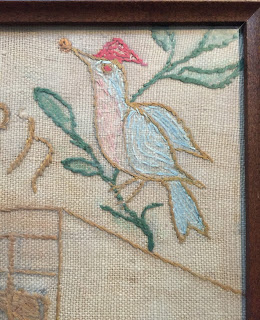A couple of weeks ago, my book club met for brunch at my friend's house. Linda has a lovely home surrounded by an incredible garden, so it is always a treat to visit. Her walls are covered with family photos and heirlooms, and I (Teri) find myself drawn to the stories on her walls.
 |
| The Old Home Kitchen, 1864 |
One of the first things I noticed upon my arrival was this lovely framed stitching of a kitchen, dated 1864. It's no surprise that I asked her about it. Here is her story.
The Old Home Kitchen was stitched by Maria Hartlein Weller, wife of Gideon. Maria was Linda's grandfather's grandmother. Linda says she likes to imagine Maria sitting in her kitchen sketching and stitching the room. It is stitched on linen, primarily with an outline stitch. We think the color may have been added using chalk, for chalk appears to have been the medium for coloring the sketches in this fraktur, also from Maria and Gideon's home.
Linda surmised that Maria quite likely used the design in this fraktur as inspiration for the birds on her embroidery. The birds on the top of the kitchen piece and those at the bottom of the fraktur show strong similarities.
She changed the color of the birds in her embroidery, but the shape of the birds and even the leaves mirror those in the pictures on the left.
I'm fascinated by the date centered at the top of the embroidery. It is simultaneously subtle and bold. Maria chose a color that was almost as light as her background, yet it is rather large; at least as large as the title. The stitching itself is intriguing. Part of the numbers are stitched the same way as her letters, with a very close stem stitch. Yet she added more to the numbers; it almost appears as though there are random stitches scattered on some of the numbers, but I feel certain Maria had a plan. Perhaps she was trying to give the numbers more dimension. The date is clearly an important element in her design. I'd love to know what the red embroidered line above the 6 represents. And the scrolled design with the running stitch is a lovely way to separate the title from "the kitchen."
I don't know about you, but this picture draws me right into that room, 150 years ago. I want to sit down in that green rocking chair by the wood stove, drink a cup of tea, and have a chat with Maria. According to Linda, the crocks on the top shelf—also above the cabinet in the full picture above—were evidently filled with milk left to get sour. So I presume they must have made their own cheese, which she might share during my stay. Maybe I could help her to spin some wool on that spinning wheel. What a lovely visit that would be!
 |
| Maria and Gideon Weller |
While Linda and I were talking, she pulled out a notebook full of family history, including typed anecdotes and newspaper clippings. She told me that at one point Maria became quite ill, and her husband, Gideon, needed help to take care of her. Their son had died, so his wife moved in to help care for her mother-in-law. After Maria died, Gideon married his daughter-in-law, and they had a large family.
Many thanks to my friend, Linda, for sharing her stories with me and allowing me to share with you. Isn't is inspiring to think that the works we stitch today can tell our stories to generations hundreds of years from now? Let's stitch our stories!
| Linda's garden had this amazing hydrangea bush covered with blooms of various colors. |







No comments:
Post a Comment